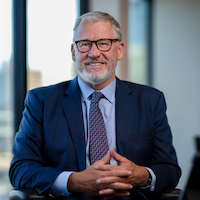Q&A with Daniel Madhavan on the results of Australia's inaugural impact investment survey

Over 120 investors, accounting for more than $333 billion of Australia's funds under management, participated in Australia's inaugural impact investment survey, with the results launched this week by Impact Investing Australia and the University of Melbourne.
We asked Impact Investing Australia CEO, Daniel Madhavan to elaborate on some of the results.
You can download a copy of the report here.
There have been 2 social benefit bonds in New South Wales to 'test the capacity'. Will this survey be used to lobby the government, both state and federal, to be more active and faster in developing new opportunities for investment?
Impact investment can be a powerful tool for governments to both leverage and work alongside. Private capital can provide funding solutions that are additive to the system and can provide a multiplier effect to funding by government. We believe there is a range of data contained in the report that might be utilised to inform policy decisions including;
* Insights into the interest and future prospects for impact investments that demonstrate the momentum and demand that is building in Australia.
* Impact areas where there are high levels of interest to mobilise private capital towards issues of importance to government, for example housing and healthcare.
* Challenges and opportunities that have been identified by investors where government can play a role in supporting market development.
The survey results show that investors who are already active in Social Impacting would like to triple their investments over the next 5 years. How will the demand for the appetite be met?
The most natural way to build the supply of investment product is to support the development of a healthy market ecosystem. This includes supporting existing and new intermediaries like fund managers to build specialist capability and products.
We can allow this to develop organically in response to the rising demand and momentum but this response is likely to take longer than we would like. Ideally we develop a mechanism to accelerate the development of this ecosystem. We believe Australia needs to establish an institution who takes on the role as a wholesale funding source and cornerstone investor for new funds and product. A collaboration of organisations and individuals have provided a blueprint for what this institution would look like and how it could be established that can be found here.
The survey result shows a lack of knowledge of social impacting investing. What role will Impact Investing Australia play in the education process?
Different stakeholders including investors are at different points of understanding and engaging with impact investing.
* For investors at the beginning of that journey we provide a range of resources including case studies that can help bring the field and its investment options to life.
* For those that have decided to move beyond interest towards action we collaborate and support opportunities to bring these early adopters together like the Asia Pacific Impact Investment Summit that was held in Sydney last year.
* For more specific issues or where there are opportunities to deep dive on certain impact areas (eg affordable housing) or investment types (eg social impact bonds) we often seek to bring smaller groups together to explore these topics in a deeper dialogue.
Most super funds have been grappling with how they engage their members. Does impact investment offer super funds a platform for engaging their members on issues they care about?
To answer your question more directly a very simple way is to understand the composition of their membership base. Are their members working in healthcare? Social service delivery? Law and order? Education? Surely the industry provides an early insight into what issues their members are likely to care deeply about.
Super funds understand the significance of the collective assets they control. Our assets. They are exploring and grappling with the questions about where their duties extend. With so much of our country's wealth in their care they have an important contribution to make in how resources are deployed to support the future we all want to see. It's a big responsibility and one they are taking seriously.
Some super fund members may be as interested in the impact that their investments make socially as financially, however the survey result show that those investing the money have a clear expectation for competitive market rates of return. What are your thoughts on this?
We don't believe that investors need to be forced into a trade off between social return and financial return. We believe there are opportunities where both an attractive financial and social return can be achieved including;
* Accessing the growth within developing markets and addressing issues of financial inclusion like those offered by funds such as LeapFrog.
* Opportunities to support programs that are addressing issues affecting children in out of home care like the social impact bonds in NSW issued by The Benevolent Society and Uniting Care Burnside.
* Financing clean energy projects by buying Green Bonds from banks such as those offered to investors last year by NAB and ANZ.
All of these opportunities have demonstrated attractive returns with an intentional and measurable social or environmental impact.
Whilst we also recognise that there may be some investors that are willing to provide finance at sub-market rates based on the social impact that may be achieved in a particular investment the results of the survey demonstrate that this is not the predominant expectation of investors.




